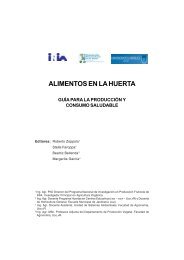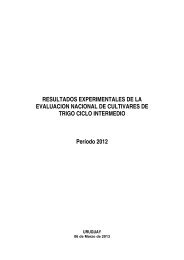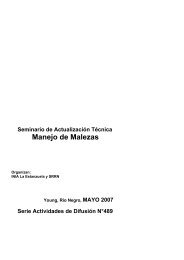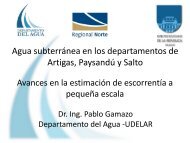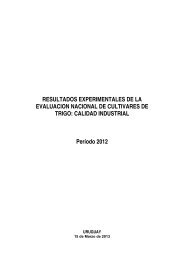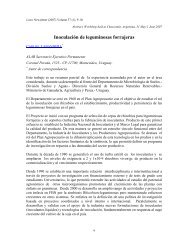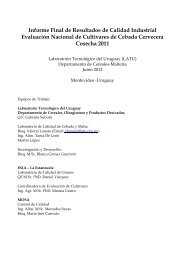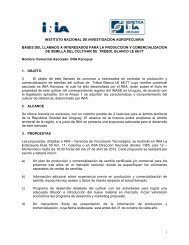(Lotus corniculatus L) hays - Inia
(Lotus corniculatus L) hays - Inia
(Lotus corniculatus L) hays - Inia
Create successful ePaper yourself
Turn your PDF publications into a flip-book with our unique Google optimized e-Paper software.
<strong>Lotus</strong> Newsletter (2006) Volume 36 (1), 11-21.<br />
Effect of maturity stage on the nutritive value of birdsfoot trefoil<br />
(<strong>Lotus</strong> <strong>corniculatus</strong> L) <strong>hays</strong><br />
ALI KARABULUT 1 , ONDER CANBOLAT 1 and ADEM KAMALAK *2<br />
1 Bursa Uludag University, Faculty of Agriculture, Department of Animal Nutrition, Bursa,<br />
Turkey<br />
2 Kahramanmaras Sutcu Imam University, Faculty of Agriculture, Department of Animal<br />
Nutrition, Kahramanmaras, Turkey. Fax: 00 90 344 2230048<br />
*Corresponding author<br />
Abstract<br />
The aim of this study was to determine the effect of maturity stage on the chemical<br />
composition, gas production kinetics, organic matter digestibility (OMD) and metabolizable<br />
energy (ME) content of <strong>Lotus</strong> <strong>corniculatus</strong> hay. Gas production were determined at 0, 3, 6,<br />
12, 24, 48, 72 and 96 h and their kinetics were described using the equation p = a + b(1-e -ct ).<br />
Maturity had a significant effect on the chemical composition, gas production kinetics,<br />
OMD and ME content of <strong>Lotus</strong> <strong>corniculatus</strong> hay. Neutral detergent fibre (NDF), acid<br />
detergent fibre (ADF) and acid detergent lignin (ADF) contents of <strong>Lotus</strong> <strong>corniculatus</strong> hay<br />
increased with increasing maturity whereas the crude protein (CP) and ether extract (EE)<br />
contents decreased. The crude protein content of <strong>Lotus</strong> <strong>corniculatus</strong> hay ranged from 14.96<br />
to 17.63 %. NDF, ADF and ADL contents ranged from 31.59 to 37.62 %, 25.73 to 31.06 %<br />
and 14.49 to 17.75% respectively.<br />
The gas production kinetics, OMD and ME content of <strong>Lotus</strong> <strong>corniculatus</strong> decreased with<br />
increasing maturity. The OMD and ME contents of <strong>Lotus</strong> <strong>corniculatus</strong> hay ranged from<br />
68.61 to 74.45%, 10.18 to 11.03 MJ/kg DM respectively. The gas production kinetics, OMD<br />
and ME content were negatively correlated with NDF, ADF and ADL content of <strong>Lotus</strong><br />
<strong>corniculatus</strong> hay whereas the same parameters were positively correlated with CP of <strong>Lotus</strong><br />
<strong>corniculatus</strong> hay. It was concluded that <strong>Lotus</strong> <strong>corniculatus</strong> hay will provide more CP and<br />
ME energy for ruminants when harvested or grazed at vegetative and flowering stage.<br />
Key words: Birdsfoot trefoil, <strong>Lotus</strong> <strong>corniculatus</strong>, Chemical composition, Maturity,<br />
Digestibility, Metabolizable Energy<br />
Introduction<br />
Birdsfoot trefoils (<strong>Lotus</strong> <strong>corniculatus</strong> L.) is a drought resistant forage legume plant which<br />
tolerates low soil fertility and can be used for grazing in many countries (Beuselinck and<br />
Grant, 1995; Foo et al., 1996). <strong>Lotus</strong> <strong>corniculatus</strong> is of interest because of its condensed<br />
tannins and its effects on animal production. Condensed tannins in <strong>Lotus</strong> <strong>corniculatus</strong> may<br />
11
12 Ali Karabulut, Onder Canbolat and Adem Kamalak<br />
form stable complexes with dietary protein in the rumen, thereby increasing the proportion<br />
of bypass protein (Hedqvist et al., 2000). Although some researches have been carried out by<br />
several researches in the most parts of world (Min et al., 2001; Hedqvist et al., 2000;<br />
Ramirez- Restrepo et al., 2004; 2005) there is limited report on the nutritive value of <strong>Lotus</strong><br />
<strong>corniculatus</strong> in Turkey. Accurate prediction of forages quality during the growth cycle<br />
would allow targeting of harvest or grazing to desired levels of nutritive composition to meet<br />
specific animal requirements (Valente et al., 2000). The chemical composition and in vitro<br />
gas production technique were widely used to evaluate the nutritive value of forages used in<br />
ruminant nutrition (Evitayani et al., 2004; Larbi et al., 1998; Tolera et al., 1997).<br />
The aim of this study was to determine the effect of maturity stage on the nutritive value of<br />
<strong>Lotus</strong> <strong>corniculatus</strong> hay in terms of chemical composition, gas production kinetics, OMD and<br />
ME content using in vitro gas production technique.<br />
Materials and Methods<br />
Hay samples<br />
Birdsfoot trefoil plants at vegetative, flowering, and mature stages were hand harvested from<br />
at least three replicate plots established in the experimental field in Bursa, Turkey, in 2005.<br />
The experimental design was a randomized complete block design with three replications.<br />
Samples were shade-dried and representative dry samples from each plot was taken to<br />
laboratory and milled in a hammer mill through a 1 mm sieve for subsequent analysis.<br />
Chemical analysis<br />
Ash content was determined by igniting the dry samples in muffle furnace at 525 o C for 8 h.<br />
Nitrogen (N) content was measured by the Kjeldhal method (AOAC, 1990). Neutral<br />
detergent fibre (NDF), Acid detergent fibre (ADF) and Acid detergent lignin (ADL) content<br />
was determined by the method of Van Soest et al. (1991). Condensed tannin (CT) was<br />
determined by butanol-HCl method as described by Makkar et al. (1995). All chemical<br />
analyses were carried out in triplicate.<br />
Crude protein (CP) was calculated as N X 6.25. Ether extract (EE) was determined by the<br />
method of AOAC (1990).<br />
In vitro gas production<br />
Rumen fluid was obtained from two fistulated sheep fed twice daily with a diet containing<br />
alfalfa hay (60%) and concentrate (40%). Samples were incubated in vitro rumen fluid in<br />
calibrated glass syringes following the procedures of Menke and Steingass (1988). 0.200 g<br />
dry weight of the sample was weighed into calibrated glass syringes of 100 ml. The syringes<br />
were prewarmed at 39 o C before the injection of 30 ml rumen fluid-buffer mixture into each<br />
syringe followed by incubation in a water bath at 39 o C. The syringes were gently shaken 30<br />
min after the start of incubation and every hour for the first 10 h of incubation. Readings of<br />
gas production recorded before incubation (0) and 3, 6, 12, 24, 48, 72 and 96 h after<br />
incubation. Cumulative gas production data were fitted to the model of Orskov and<br />
McDonald (1979):
<strong>Lotus</strong> <strong>corniculatus</strong> nutritive value 13<br />
y= a + b (1-e -ct )<br />
Where<br />
a = the gas production from the immediately soluble fraction (ml)<br />
b = the gas production from the insoluble fraction (ml)<br />
c = the gas production rate constant for the insoluble fraction (b)<br />
t = incubation time (h)<br />
y = gas produced at time ‘t’<br />
The metaobilzable energy (ME) (MJ/kg DM) content of <strong>Lotus</strong> <strong>corniculatus</strong> hay samples was<br />
calculated using equation of Menke et al. (1979) as follows:<br />
ME (MJ/kg DM) = 2.20 + 0.136 GP + 0.057 CP<br />
Where<br />
GP = 24 h net gas production (ml/200 mg).<br />
CP = Crude protein (%)<br />
Organic matter digestibility (OMD) (%) of <strong>Lotus</strong> <strong>corniculatus</strong> hay samples was calculated<br />
using equation of Menke et al. (1979) as follows:<br />
OMD (%) = 14.88 + 0.889GP + 0.45CP +0.0651 XA<br />
Where<br />
GP = 24 h net gas production (ml/200 mg).<br />
CP = Crude protein (%)<br />
XA = Ash content (%)<br />
Statistical analysis<br />
One-way analysis of variance (ANOVA) was carried out to compare chemical composition,<br />
gas production kinetics, OMD and ME content of <strong>Lotus</strong> <strong>corniculatus</strong> hay with stage as the<br />
main factor using General Linear Model (GLM) of Statistica for Windows (1993).<br />
Significance between individual means was identified using the Tukey’s multiple range test<br />
(Pearse and Hartley, 1966). Mean differences were considered significant at P
14 Ali Karabulut, Onder Canbolat and Adem Kamalak<br />
Table 1. The effect of maturity stage on the chemical composition (% of DM) of <strong>Lotus</strong><br />
<strong>corniculatus</strong> hay.<br />
Maturity Stages<br />
Parameters Vegetative Flowering Mature SEM Sig.<br />
Ash 7.03 b 7.29 c 6.45 a 0.045 ***<br />
EE 5.18 b 4.42 a 4.33 a 0.140 ***<br />
CP 17.63 c 17.15 b 14.96 a 0.120 ***<br />
NDF 31.59 a 34.62 b 37.62 c 0.118 ***<br />
ADF 25.73 a 27.69 b 31.06 c 0.084 ***<br />
ADL 14.49 a 16.77 b 17.75 c 0.115 ***<br />
CT 2.27 2.19 2.05 0.089 NS<br />
Means within the same row with various superscripts are significant. SEM = Standard<br />
error mean, Sig = significance level, NS = Non-significant, ***P
<strong>Lotus</strong> <strong>corniculatus</strong> nutritive value 15<br />
that EE content of Gundelia tuonefortii hay increased with increasing maturity.<br />
NDF, ADF and ADL contents of <strong>Lotus</strong> <strong>corniculatus</strong> hay were significantly increased with<br />
advancing maturity. NDF, ADF and ADL contents ranged from 31.59 to 37.62 %, 25.73 to<br />
31.06 % and 14.49 to 17.75% respectively. NDF and ADF contents of <strong>Lotus</strong> <strong>corniculatus</strong><br />
hay are comparable with findings of Niezen et al. (2002) who reported that NDF and ADF<br />
contents harvested in summer and autumn ranged from 26.9 to 31.6 and 20.3 to 25.7%,<br />
respectively.<br />
NDF, ADF and ADL contents of <strong>Lotus</strong> <strong>corniculatus</strong> hay harvested at vegetative stage was<br />
significantly (P
16 Ali Karabulut, Onder Canbolat and Adem Kamalak<br />
<strong>corniculatus</strong> hay decreased with increasing maturity and ranged from 62.9 to 74.0%, 9.7 to<br />
11.2 MJ/kg DM, respectively. These results are also consistent with findings of Niezen et al.<br />
(2002) who found that OMD and ME content of <strong>Lotus</strong> <strong>corniculatus</strong> hay summer and autumn<br />
ranged from 71.5 to 72.6%,10.7 to 11.6 MJ/kg DM, respectively.<br />
8<br />
0<br />
Gas production (ml)<br />
6<br />
0<br />
4<br />
0<br />
2<br />
0<br />
Vegetative<br />
Flowering<br />
Mature<br />
0<br />
0 20 40 60 80 100<br />
Incubation times (Hour)<br />
Figure 1. The effect of maturity stage on the in vitro gas production of <strong>Lotus</strong><br />
<strong>corniculatus</strong> hay<br />
NDF, ADF and ADL contents increased with increased maturity (Table 1). An increase in<br />
NDF, ADF and ADL contents resulted in the lower gas production (b) from insoluble<br />
fraction and potential gas production (a+b) with increased maturity.<br />
Gas production kinetics (c a, b (a+b)), ME and OMD were negatively correlated with cell<br />
wall contents (NDF, ADF and ADL; Table 3). This result is consistent with findings<br />
reported by Kamalak et al. (2005 a, b), Ndlovu and Nherera (1997), Larbi et al. (1998), and<br />
Abdulrazak et al. (2000).
<strong>Lotus</strong> <strong>corniculatus</strong> nutritive value 17<br />
Table 2. The effect of maturity stage on the gas production kinetics, organic matter<br />
digestibility (%) and metabolizable energy (MJ / kg DM) of <strong>Lotus</strong> <strong>corniculatus</strong> hay<br />
Maturity Stages<br />
Parameters Vegetative Flowering Mature SEM Sig.<br />
c 6.46 c 6.16 b 5.75 a 0.077 ***<br />
a 2.84 b 3.10 b 2.06 a 0.141 ***<br />
b 70.97 b 68.83 a 68.06 a 0.425 ***<br />
a+b 73.81 c 71.93 b 70.12 a 0.415 ***<br />
OMD 74.45 c 71.70 b 68.61 a 0.499 ***<br />
ME 11.03 c 10.62 b 10.18 a 0.076 ***<br />
c = gas production rate (%), a = gas production (mL) from quickly soluble fraction, b<br />
= gas production (mL) from the insoluble fraction, a+b = potential gas production<br />
(mL). Means within the same row with various superscripts are significant.<br />
SEM=Standard error mean, Sig. - significance level, ***P
18 Ali Karabulut, Onder Canbolat and Adem Kamalak<br />
Conclusion<br />
The maturity stage had a significant effect on the chemical composition, in vitro gas<br />
production kinetics and organic matter digestibility and metabolizable energy contents of<br />
<strong>Lotus</strong> <strong>corniculatus</strong> hay. Cell wall contents of <strong>Lotus</strong> <strong>corniculatus</strong> hay increased with<br />
increasing maturity whereas the crude protein (CP) decreased with increased maturity. As a<br />
result of these the organic matter digestibility and metabolizable energy content decreased<br />
with increased maturity. It was concluded that <strong>Lotus</strong> <strong>corniculatus</strong> hay will provide more CP<br />
and ME energy for ruminants when harvested or grazed at vegetative and flowering stage.<br />
References<br />
ABDULRAZAK S.A., FUJIHARA T., ONDIEK J.K. and ORSKOV E. 2000. Nutritive evaluation<br />
of some Acacia tree leaves from Kenya. Animal Feed Science Technology, 85, 89-98.<br />
AOAC. 1990. Official Method of Analysis. (15 th . ed) Association of Official Analytical<br />
Chemist, Washington DC, USA. pp.66-88<br />
BEUSELINCK P.R and GRANT W.F. 1995. Birdsfoot trefoil. In BARNES R.F., MILLER D. and<br />
NELSON C.J. (Eds.) Forages. 5th Edition, Iowa State University Press, Ames, Iowa,<br />
USA. pp. 237-248.<br />
BUTTER N.L., DAWSON J.M., WAKELIN D. and BUTTERY P.J. 1998. Effect of dietary tannin<br />
and protein level on the susceptibility of sheep to parasitic infection. Proceeding of<br />
British Society of Animal Science. p. 97.<br />
BUXTON D.R. 1996. Quality related characteristics of forages as influenced by plant<br />
environment and agronomic factors. Animal Feed Science Technology, 59, 37-49.<br />
DOUGLAS G.B., WANG Y., WAGHORN G.C., BARRY T.N., PURCHAS R.W., FOOTE A.G.<br />
and WILSON G.F. 1995. Liveweight gain and wool production of sheep grazing<br />
<strong>Lotus</strong> <strong>corniculatus</strong> and Lucerne (Medicago sativa). New Zealand Journal of<br />
Agricultural Research, 38, 95-104.<br />
EVITAYANI L., WARLY A., FARIANI T., ICHINOHE A., ABDULRAZAK A. and FUJIHARA T.<br />
2004. Comparative rumen degradability of some legume forages between wet and<br />
dry season in West Sumatra, Indonesia. Asian-Australasian Journal of Animal<br />
Science, 17(8), 1107-1111.<br />
FOO L.Y., NEWMAN R., WAGHORN G., MCNABB W.C. and ULYATT M.J. 1996.<br />
Proanthyocyanidins from <strong>Lotus</strong> <strong>corniculatus</strong>. Phytochemistry, 41, 617-624.
<strong>Lotus</strong> <strong>corniculatus</strong> nutritive value 19<br />
HEDQVIST H., MUELLER-HARVEY I., REED J.D., KRUEGER C.G. and MURPHY M. 2000.<br />
Characterisation of tannins and in vitro protein digestibility of several <strong>Lotus</strong><br />
<strong>corniculatus</strong> varieties. Animal Feed Science and Technology, 87 (1-2), 41-56.<br />
HIDES D.I.I., LOVATT J.A. and HAYWARD M.V. 1983. Influence of stage of maturity on the<br />
nutritive value of Italian ryegrass. Grass and Forage Science, 38, 33-38.<br />
KAMALAK A., CANBOLAT O., GURBUZ Y., EROL A. and OZAY O. 2005a. Effect of maturity<br />
stage on the chemical composition, in vitro and in situ degradation of tumbleweed<br />
hay (Gundelia tuonefortii L.). Small Ruminant Research, 58, 149-156.<br />
KAMALAK A., CANBOLAT O., GURBUZ Y., OZKAN C.O. and KIZILSIMSEK M. 2005b.<br />
Determination of nutritive value of wild mustard, Sinapsis arvensis harvested at<br />
different maturity stages using in situ and in vitro measurements. Asian-Australasian<br />
Journal of Animal Sciences, 18 (9), 1249-1254.<br />
LARBI A., SMITH J.W., KURDI I.O., ADEKUNLE I.O., RAJI A.M. and LADIPO D.O. 1998.<br />
Chemical composition, rumen degradation, and gas production characteristics of<br />
some multipurpose fodder trees and shrubs during wet and dry seasons in humid<br />
tropics. Animal Feed Science and Technology, 72, 81-96.<br />
LEE M.J., HWANG S.Y. and CHIOU P.W.S. 2000. Metabolizable energy of roughages in<br />
Taiwan. Small Ruminant Researchm, 36, 251-259.<br />
MAKKAR H.P.S., BLUMMEL M. and BECKER K. 1995. Formation of complexes between<br />
polyvinyl pyrrolidones or polyethylene glycols and their implication in gas<br />
production and true digestibility in vitro techniques. British Journal of Nutrition, 73,<br />
897-913.<br />
MENKE K.H. and STEINGASS H. 1988. Estimation of the energetic feed value obtained from<br />
chemical analysis and in vitro gas production using rumen fluid. Animal Research<br />
Development, 28, 7-55.<br />
MENKE K.H., RAAB L., SALEWSKI A., STEINGASS H., FRITZ D. and SCHNEIDER W. 1979.<br />
The estimation of digestibility and metabolizable energy content of ruminant<br />
feedstuffs from the gas production when they incubated with rumen liquor in vitro.<br />
Journal of Agricultural Science. (Camb.), 92, 217-222.<br />
MIN B.R., FERNANDEZ J.M., BARRY T.N., MCNABB W.C. and KEMP P.D. 2001. The effect<br />
of condensed tannins in <strong>Lotus</strong> <strong>corniculatus</strong> upon reproductive efficiency and wool<br />
production in ewes during autumn. Animal Feed Science and Technology, 92(3-4),<br />
185-202. .<br />
MINSON D.J. 1990. Forage in ruminant nutrition. Academic Press, New York. p.483.
20 Ali Karabulut, Onder Canbolat and Adem Kamalak<br />
MORRISON J.M. 1980. Changes in the lignin and hemicellulose concentration of ten<br />
varieties of temperate grasses with increasing maturity. Grass and Forage Science,<br />
32, 287-293.<br />
NDLOVU L.R. and NHERERA F.V. 1997. Chemical composition and relationship to in vitro<br />
gas production of Zimbabwean browsable indigenous tree species. Animal Feed<br />
Science and Technology, 69, 121-129.<br />
NIEZEN J.H., WAGHORN G.C., CHARLESTON W.A.G. and WAGHORN G.C. 1995. Growth<br />
and gastrointestinal nematode parasitism in lambs grazing either Lucerne or sulla<br />
which contains condensed tannin. Journal of Agricultural Science (Camb.), 12,<br />
281-289.<br />
NIEZEN J.H., WAGHORN T.S., GRAHAM T., CARTER J.L. and LEATHWICK D.M. 2002. The<br />
effect of diet fed to lambs on subsequent development of Trichostrongylus<br />
colubriformis larvae in vitro and on pasture. Veterinary Parasitology, 105, 26-283.<br />
ORSKOV E.R and MCDONALD I. 1979. The estimation of protein degradability in the rumen<br />
from incubation measurements weighted according to rate of passage. Journal of<br />
Agricultural Science (Camb.), 92, 499-503.<br />
PEARSE E.S. and HARTLEY H.O. 1966. Biometrika tables for statisticians. Vol.1. Cambridge<br />
University Press, UK. pp1-270.<br />
RAMÍREZ-RESTREPO C.A., BARRY T.N., LÓPEZ-VILLALOBOS N., KEMP P.D. and MCNABB<br />
W.C. 2004. Use of <strong>Lotus</strong> <strong>corniculatus</strong> containing condensed tannins to increase lamb<br />
and wool production under commercial dryland farming conditions without the use<br />
of anthelmintics. Animal Feed Science Technology, 117, 85-105.<br />
RAMÍREZ-RESTREPO C.A., BARRY T.N., LÓPEZ-VILLALOBOS N., KEMP P.D. and HARVEY<br />
T.G. 2005. Use of <strong>Lotus</strong> <strong>corniculatus</strong> containing condensed tannins to increase<br />
reproductive efficiency in ewes under commercial dryland farming conditions.<br />
Animal Feed Science and Technology, 121, 23-43.<br />
RAMIREZ-RESTREPO C.A., BARRY T.N. and LÓPEZ-VILLALOBOS N. 2006. Organic matter<br />
digestibility of condensed tannin-containing <strong>Lotus</strong> <strong>corniculatus</strong> and its prediction in<br />
vitro using celulase/hemicellulase enzymes. Animal Feed Science Technology, 125,<br />
61-71.<br />
ROBERTSON H.A., NIEZEN J.H., WAGHORN G.C., CHARLESTON W.A.G. and JINLOG M.<br />
1995. The effect of six herbage on liveweight gain, wool growth and feacal egg count<br />
of parasited ewe lamb. Proceeding of New Zealand Society of Animal Production,<br />
55, 199-201.<br />
STATISTICA. 1993. Statistica for windows release 4.3, StatSoft, Inc. Tulsa, OK.
<strong>Lotus</strong> <strong>corniculatus</strong> nutritive value 21<br />
TERRY R.A. and TILLEY J.M.A. 1964. The digestibility of the leaves and stems of perennial<br />
ryegrass, cooksfood, timothy, tall fescue, Lucerne and sainfoin, as measured by an in<br />
vitro procedure. Journal of British Grassland Society, 19, 363-372.<br />
TOLERA A., KHAZAAL K. and ORSKOV E.R. 1997. Nutritive evaluation of some browse<br />
species. Animal Feed Science Technology, 67, 181-195.<br />
VALENTE M.E., BORREANI G., PEIRETTI P.G. and TABACCO E. 2000. Codified<br />
morphological stage for predicting digestibility of Italian Ryegrass during the spring<br />
cycle. Agronomy Journal, 92, 967-973.<br />
VAN SOEST P.J., ROBERTSON J.D. and LEWIS B.A. 1991. Methods for dietary fibre, neutral<br />
detergent fibre and non-starch polysaccharides in relation to animal nutrition.<br />
Journal of Dairy Science, 74, 3583-3597.<br />
WAGHORN G.C., ULYATT M.J., JOHN A. and FISHER M.T. 1987. The effect of condensed<br />
tannins on site of digestion of amino acids and other nutrients in sheep fed on <strong>Lotus</strong><br />
<strong>corniculatus</strong> L. British Journal of Nutrition, 57, 115-126.<br />
WANG Y., DOUGLAS G.B., WAGHORN G.C., BARRY T.N. and FOOTE A.G. 1996. Effect of<br />
condensed tannin upon lactation performance in ewes. Journal of Agricultural<br />
Science (Camb.), 126, 353-362.<br />
WILSON J.R., DENIUM H. and ENGELS E.M. 1991 Temperature effects on anatomy and<br />
digestibility of leaf and stem of tropical and temperate forage species. Netherlands<br />
Journal of Agricultural Science, 39, 31-48.<br />
ZINASH S., OWEN E., DHANOA M.S. and THEODOROU M.K. 1996. Prediction of in situ<br />
rumen dry matter disappearance of Ethiopian forages from an in vitro gas production<br />
technique using a pressure transducer, chemical analyses or in vitro digestibility.<br />
Animal Feed Science Technology, 61, 73-87.



